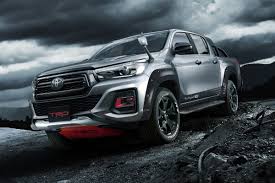
Why Are the Toyota Tacoma and Hilux Different Trucks?
If you love Toyota trucks or are looking for a great midsize pickup, you’ll want the Toyota Hilux. Unfortunately, in a confusing scenario that is not easily explained, if you live in the US you can’t buy one. So we’re going to drill down to see what the reasons are and why the Tacoma was the best choice for American truck buyers.
Both trucks are considered midsize pickups and are almost identical in size. Even the frames, though not identical are similar, though we’ll get to the differences below. The Tacoma is slightly wider, which is typical for an American vehicle. Both Japan and Australia have restrictions on vehicle width which can sometimes result in different vehicles for the same type of market.
Hilux Redesign In 1986
The Hilux in America was redesigned in 1986 and received an independent front suspension, while the previous Hilux remained elsewhere in the world with the solid front axle. This boosted sales in the US where it was determined a better-handling and riding midsize was what the market wanted. The international Hilux handled off-road situations better with the solid axle front, and also offered a limited-slip diff that was not available on the new American version.

Hilux and Tacoma Split
In 1995 the all-new Tacoma became available in the US. The front independent suspension was again redesigned with a weaker double A-arm set up and rack and pinion steering sourced from a passenger car. Something that did suggest off-road capabilities was the electric rear locker option. That and larger tires helped to promote the Tacoma as being off-road capable.
Hilux Changes For 1998
During this time the Hilux saw limited interior and styling changes. Then in 1998, the Hilux received its most significant changes. The frame was switched to the former Tacoma frame used in 1985-1995 Tacomas. It was a boxed frame internally gusseted, capable of one-ton loads. The new Tacomas were only rated for one-half ton loads.

The suspension for the new/old Hilux frames was redesigned to be stouter and more off-road capable. The steering used on previous Hilux models was retained, now with a small skid plate for added protection. So now this older Tacoma frame is what underpins the current Hilux.
Japan views the Hilux as a more rugged, durable truck the rest of the world demands. The Tacoma has been softened for the highway and everyday-vehicle use it sees. Toyota feels if a more rugged application is called for the customer will likely go to a full-size truck solution. Obviously the Tacoma does not fit that profile.
Hilux And Tacoma Differences
There are other differences besides the frames and suspensions, like the Tacoma is not available as a single cab. Single cab pickups are finding fewer customers in the US as buyers see the advantages of extra room in an extended cab or the convenience of four doors in a crew cab.


But in international markets the single cab can be sold without a bed, so outside suppliers can add specific commercial bodies. Tow truck bodies, tank bodies, and flatbeds are just some of the choices a commercial buyer has when ordering a chassis-cab truck. The Hilux can be ordered that way. Also, it has one-ton capabilities. Even the larger Tundra is only rated for half-ton loads.

Both Hilux and Tacoma share the 2.7-liter gas engine. Tacoma doesn’t get the diesel the Hilux has, and the Hilux can’t be ordered with a V6 like the Tacoma. Hilux engines have better torque ratings, while Tacoma power plants have more horsepower. We know engines can be configured for any chassis so Toyota wouldn’t need two trucks for different engine applications.
Styling is subjective and it is hard to determine if one is more appealing to US buyers, while the other appeals everywhere else. Are there really differing design preferences? We doubt it. The Tacoma is slightly more restrained in its design, while the Hilux has a bit more sculpturing and style.
Australia And Top Gear Love Hilux
It’s interesting that the Hilux is Australia’s top-selling vehicle. BBC motor show Top Gear has messed with Hilux pickups throughout the show’s life, challenging the truck’s bullet-proof reputation by putting one on a building about to be demolished, and setting it on fire. A Hilux has also been chosen by Top Gear for many other challenges the show deems to put one through. In all cases, it holds up beyond expectations increasing its appeal.

The Hilux is the go-to vehicle for militants in war-torn areas, especially in the Middle East. We’ve seen those desert shots of Hilux pickups loaded with armed soldiers with “Toyota” emblazoned on the tailgates. We don’t know whether this is the type of grass-roots advertising Toyota really wants.
So what have we learned? That the Hilux saw a major division in 1986 that has perpetuated to now. It will be interesting as we near an all-new Tacoma in the next year or so to see what Toyota does with the Hilux. Will Toyota finally combine them into one production truck, or will it continue to develop two different but similar midsize pickups?



